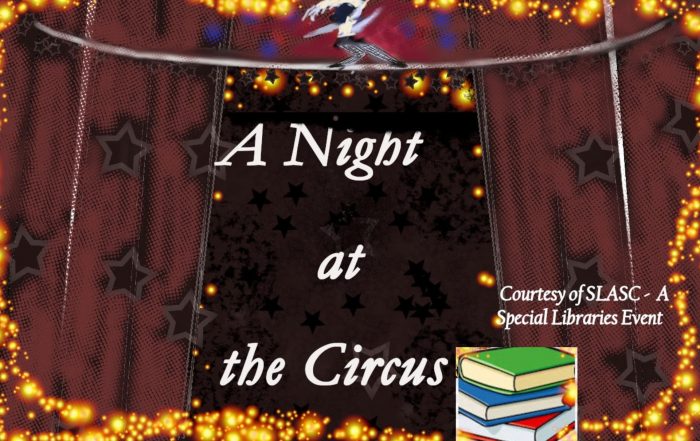
Authors: Max Gonzalez Burdick, Sarah Walters & Sereen Suleiman
Wow! Words alone cannot describe what an incredible presentation A Night At The Circus was. For those of you who missed this event, do not fret, the SLASC Blog Team has you covered! Read below to find out what happened! Also, check out the recording through our SLASC website and our very own YouTube channel located here: A Night At The Circus.
Immediately, we start with a bang, as Christina Gibson, a musician archivist from the University of Maryland, gives us a glimpse into the music behind the circus: a circus march song by Carl L. King. This readily set the stage for a great night full of presentations and performances.
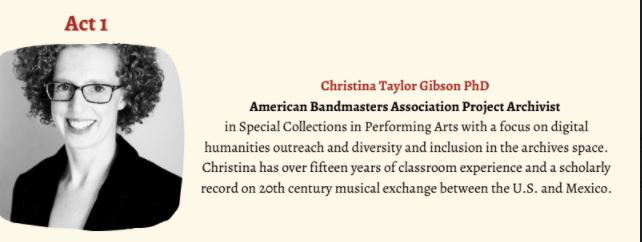
Christina begins the presentation by mentioning how music is a critical point that alludes to what is happening at the circus. For instance, a silly note can easily go hand in hand with a clown entertaining the crowd, something she refers to as a “fast-paced whirligig” sound. Moreover, Chrstina gives us a historical overview of Merle Evans and the societal issues within the circus in the early 20th century. We see a brief look at race, ethnicity, and gender, and how each of these factors play a role within performative acts in the circus. She also mentions how sometimes stereotypes would follow people based on their ethnicity in a prejudiciary musical note.
As Christina puts it, she is an American Bandmasters Association Project Archivist at the Performing Arts Library in the University of Maryland’s Clarice Smith Center. Her role is to preserve, acquire, and provide access to research materials that “document performance, instruction, and scholarship, consistent with the university’s performing arts educational objectives.” Furthermore, her professional focus is also in diversity and inclusion within an archival space. Christina posed a question for the audience to consider: “What is my responsibility toward this material as an archivist?”
The night continues with the second speaker, Maureen Brunsdale, a special collections librarian at Milner Library, Illinois State University.
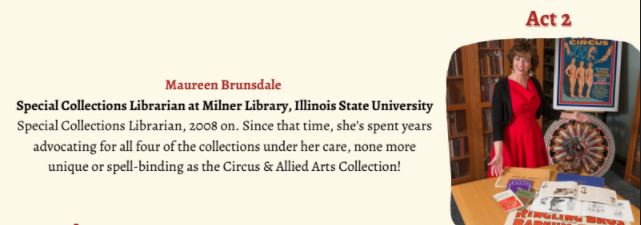
Maureen initiates her presentation with a fun trivia question: When was the first circus in the USA? After a couple of guesses, she explains that the first American circus was established in 1791 by John Bill Ricketts (almost as old as the United States!). She then proceeds to give other trivia such as explaining how, in the 1980s, librarians would generally not want to work in a special collections field. This led her to obtain the position of a special collections librarian, where her interest in circus grew fondly. She started collecting archival photographs of circus performers, most notably, the Flying Wallendas. Maureen also recounts several other people such as Lusita Leers, a famous acrobat who is known for her neckhang on the trapeze bar without any protection. Maureen brings this back to special libraries and mentions how patrons of the library come from all parts of the world to look at the special collections the library has to offer. These special collections and archival materials bring people’s history to them, as she recounts an emotional event with a former circus performer who accessed the special collection. Maureen concludes by explaining that her love for circus acts enabled her to write a book called, The Bloomington-Normal Circus Legacy: The Golden Age of Aerialists. Maureen’s main advice for MLIS students is that special collections librarians must advocate for their collections. They also need to research and learn about the topic they’re responsible for.
The third speaker up for the night was Jet Jacobs, a special collections librarian at the University of California, Los Angeles.
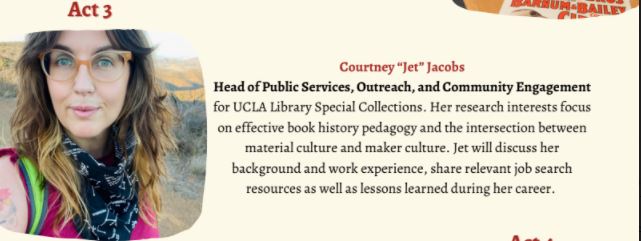
As a special collections librarian, Jet has the pleasure of working with Los Angeles Daily News negatives, including nitrate, photo, glass, and safety negatives. Furthermore, she generously shares her experience of how she acquired her job, and although she has worked in libraries for over 20 years, it took her three years to find a job out of graduate school (so don’t be overwhelmed if job searching in the library and information science (LIS) field appears challenging at first!). Jet offers great insight into how COVID-19 impacted her position. In fact, she elaborates that during covid, the UCLA special library collection was able to obtain multiple digital repositories and encourage collaborative hands-on activities. Jet concludes by offering three pieces of advice for any future special collections librarian:
- You MUST be proficient in copyright
- Supporting instruction is the main task at a special library collection
- Take classes in archives and manuscripts if you can
As the spectacle of wonders begins to wrap up, one of our own SLASC members, Assistant Webmaster Allison Williams, performs an extraordinary aerial performance showcasing her awe-inspiring talents, as a trapeze artist. Just check out this picture of her incredible aerial performance!
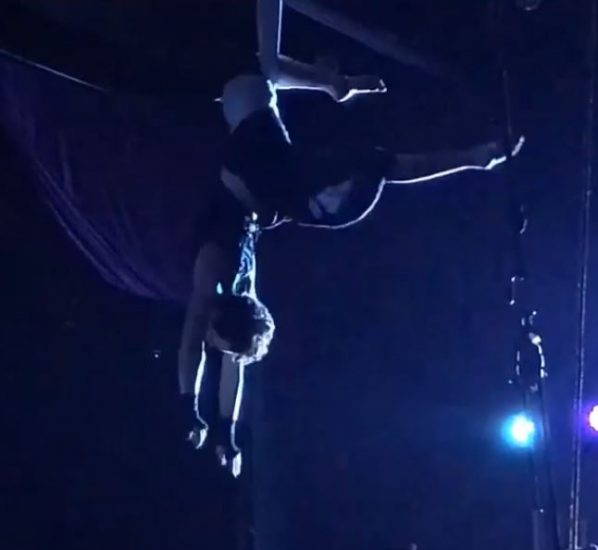
Allison Chase Williams is currently working on her Master’s in Library and Information Science at San Jose State University, iSchool, and has her B.A. in History and B.S. in Business (Marketing).
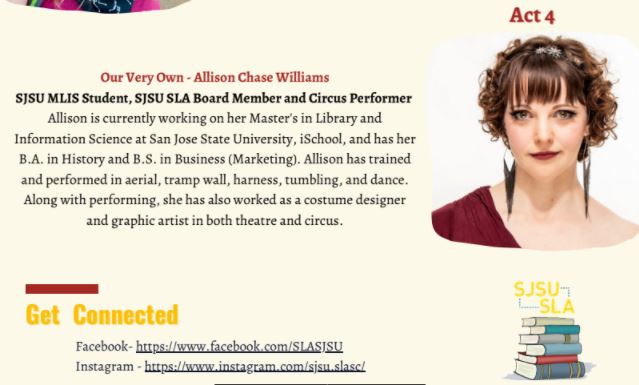
She hopes to become an archivist, special librarian, or academic librarian. Otherwise you can catch here here at the SLASC.
With this, A Night At The Circus comes to a close. Thanks for reading and don’t forget to watch the show on our YouTube page!



0 Comments